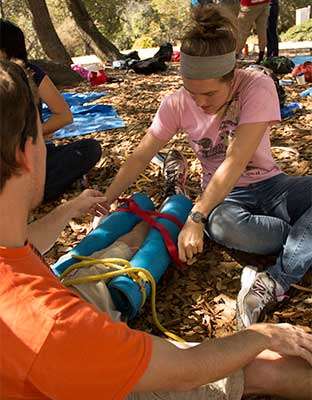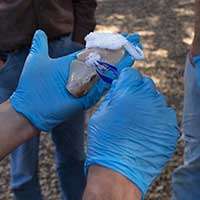When a field researcher's first aid kit is the only one for miles

Under a clear blue autumn sky, the 20 or so people gathered in UC Berkeley's Memorial Glade, with their sleeping pads and trekking poles, appeared to be part of a camping or picnic outing. In fact, they were field researchers preparing to study wilderness first aid.
"We're not MDs, we're paleontologists, so most of the things we study are already dead—but we can occasionally help folks," said Tim White, who had traded his role as professor of paleontology for that of a student for the day. When White is out in the field searching for hominid fossils, he added, "My first-aid kit is the only first-aid kit for many, many miles."
For a biologist studying an invasive plant species, an archaeologist uncovering ancient remains or an engineer delving into the inner workings of a wastewater treatment system, work may be located anywhere. Whether this means a rural California farm or a village in East Africa, emergency medical care may be hours away.
"I'm often out in remote settings with just an undergraduate or two, so I thought it'd be good [training] to have," said Lindsey Hendricks, a graduate student and researcher in integrative biology. Ben Muddiman and Briana Boaz, student researchers in paleobotany and botany, respectively, recounted how rough gravel roads and treacherous sections of trail can make it difficult to reach their field sites. Environmental factors such as heat, cold or lack of water also affect workplace safety, they added.

"I help arrange field trips for the students, so I feel like I should be aware of common first-aid procedures," said Joshua Povich, course coordinator for undergraduates in the Department of Integrative Biology.
"A lot of wilderness medicine is preventive medicine; it's the best kind of care. So it really teaches you how to lead a group and how to keep their safety always in your mind," said Aliyah Cohen, who co-taught the class.
She and fellow instructor Louis Lubow taught participants how to respond when preventive measures fall short. Both instructors work for Sierra Rescue, a Truckee-based company that teaches outdoor rescue, including health and safety courses organized around swiftwater, technical rope climbing and wilderness.
Wilderness, as defined for the Berkeley course, meant any location more than an hour from the nearest medical facility.
In patches of shade on the glade, students practiced cardiopulmonary resuscitation (CPR) on plastic dummies, learned proper wound dressing on pieces of chicken and splinted each other's limbs.
Instructors addressed trauma response, including how to assess a scene to prioritize actions, and environmental hazard response.
"I was very interested in the more mundane, like how to deal with allergies, hypothermia, heat exhaustion, those kinds of things," said Chris Lesser, a graduate student studying geography. "I think that's 99 percent of what you actually do encounter. But the anxiety is always [about] how to treat an emergency situation."
Whether headed for equatorial jungles, sub-Saharan deserts or the icy Arctic, by the end of the course the researchers in attendance were equipped to lead their teams into the field with newly acquired tools and techniques.















